Understanding Quartz Stain Remover: An In-Depth Guide
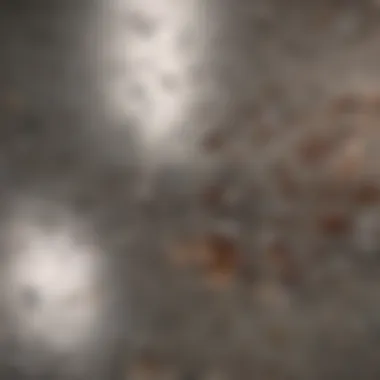
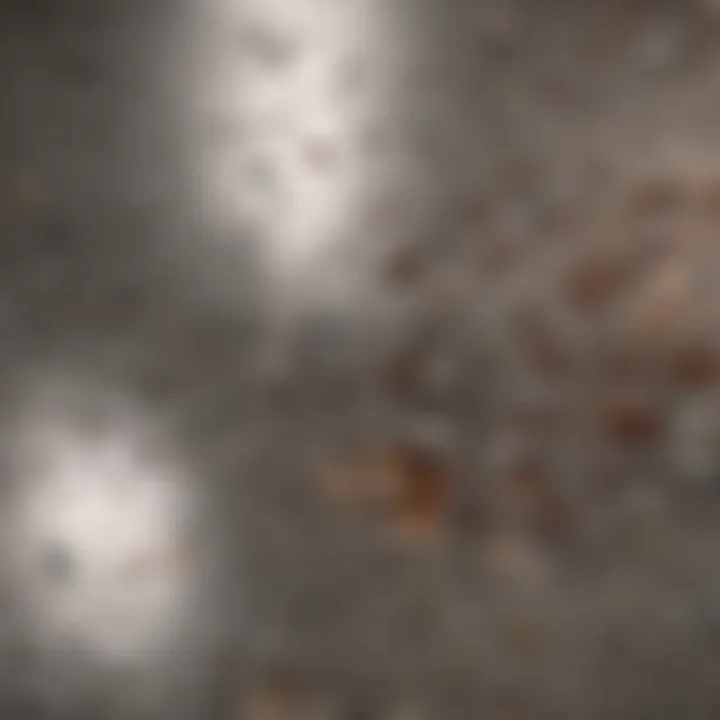
Intro
Quartz surfaces have gained significant popularity in recent years, becoming a favored choice for kitchen countertops, bathroom vanities, and various home design applications. Their durability and aesthetic appeal make them a practical option for both homeowners and interior designers alike. However, maintaining the pristine condition of quartz can be complex due to the susceptibility of these surfaces to stains and damage. Thus, understanding the properties and applications of quartz stain removers is essential for every quartz surface owner.
This guide will delve into effective cleaning techniques, provide recommendations on suitable products, and outline strategies for the ongoing maintenance of quartz surfaces. Additionally, it will clarify some common misconceptions surrounding quartz stain removers. By the end of this article, readers will grasp the vital elements required to keep quartz surfaces in excellent shape while adding longevity to their investment.
"Knowledge about the tools and methods for maintaining quartz can empower homeowners to preserve the beauty and utility of their surfaces."
Prelims to Quartz Surfaces
Understanding quartz surfaces is crucial for both homeowners and interior design enthusiasts. This knowledge establishes a foundation for quality choices in countertop materials and maintenance practices. Quartz is often favored for its aesthetic appeal, versatility, and durability. Knowing its characteristics helps in making informed decisions about cleaning and stain removal strategies.
Definition of Quartz
Quartz is a naturally occurring mineral composed primarily of silicon dioxide. It ranks among the most abundant minerals in the Earth's crust. In the context of surfaces, quartz is engineered by combining approximately 90% crushed natural quartz crystals with resins and pigments. This process results in a non-porous material that is highly resistant to staining and scratching.
The definition sets the stage for understanding not only the beauty of quartz surfaces but also their functional attributes.
Composition and Manufacturing Process
The manufacturing of quartz surfaces begins with raw materials. These include natural quartz crystals, resins, and pigments which collectively create the final product. The manufacturing process typically involves the following steps:
- Crushing: Natural quartz is crushed into small particles to allow for uniformity in the product.
- Mixing: The crushed quartz is combined with resins and pigments to achieve the desired color and surface finish.
- Molding: The mixture is then placed into molds and spread evenly to form slabs.
- Curing: Once molded, the slabs undergo curing to solidify the resins. This stage enhances durability and solidity.
- Polishing: Finally, the surface is polished to achieve a smooth texture suitable for countertops and other applications.
These processes contribute to the material's strength and non-porous nature. The composite design also means that quartz surfaces often outperform natural stone in stain resistance and ease of maintenance, making it a popular choice for kitchens and bathrooms.
"Quartz surfaces combine beauty with functionality, appealing for many applications in modern homes."
Understanding these foundational aspects of quartz surfaces provides valuable insight. It emphasizes the importance of selecting appropriate maintenance products and methods, especially when dealing with stains.
Understanding Stains on Quartz
Understanding stains on quartz is essential for maintaining the beauty and longevity of these surfaces. Quartz countertops and surfaces are increasingly popular due to their durability and low maintenance requirements. However, they are not entirely resistant to stains. Knowing the types of stains that can occur, their sources, and their potential impact can help homeowners and users take proactive measures to protect their investment.
Types of Stains
Stains on quartz surfaces can be categorized into various types, each with distinct characteristics. Some common types include:
- Organic Stains: These come from food and beverages like coffee, wine, and fruit juices. Organic stains can often penetrate the resin if not cleaned promptly.
- Inorganic Stains: Such stains originate from substances like rust or dirt. These often come from metal items placed on the surface or from outdoor exposure.
- Etching: While not a stain in the traditional sense, etching occurs when acidic substances interact with the quartz surface, leading to dull spots that disrupt the otherwise shiny finish.
Understanding these types of stains helps in determining the right cleaning method. Some require specific stain removers, while others might need a more gentle approach.
Common Sources of Stains
Stains can originate from various sources, many of which are part of daily life. Common sources include:
- Kitchen Items: Spills from cooking oils, sauces, and food residues can lead to organic staining.
- Beverages: As mentioned, drinks like coffee, red wine, and soda can leave noticeable marks.
- Household Products: Cleaning agents or products containing dyes can sometimes lead to unexpected stains.
- Environmental Factors: Exposure to the outdoors can cause dirt and plant materials to settle on quartz surfaces, leading to staining over time.
Recognizing these sources allows homeowners to adjust their routines and reduce the chance of staining.
Impact of Stains on Aesthetics and Functionality
The presence of stains can considerably affect both the visual appeal and functionality of quartz surfaces.
- Aesthetic Concerns: Stains can detract from the otherwise sleek and polished look of quartz, making spaces appear less designed and cared for. Guests may notice stains and form impressions based on the surface's appearance.
- Functional Issues: Beyond aesthetics, certain types of stains can indicate potential problems. For example, a persistent rust stain might suggest that metal items are corroding when they come into contact with moisture. Ongoing staining may lead to a loss of surface finish or even structural integrity over time.
In summary, a comprehensive understanding of stains on quartz is vital. It enables users to adopt appropriate cleaning practices and maintain the surfaces effectively. By being aware of types, sources, and impacts, homeowners can protect their surfaces and preserve their aesthetic appeal.
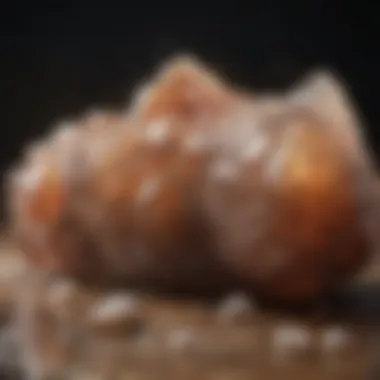
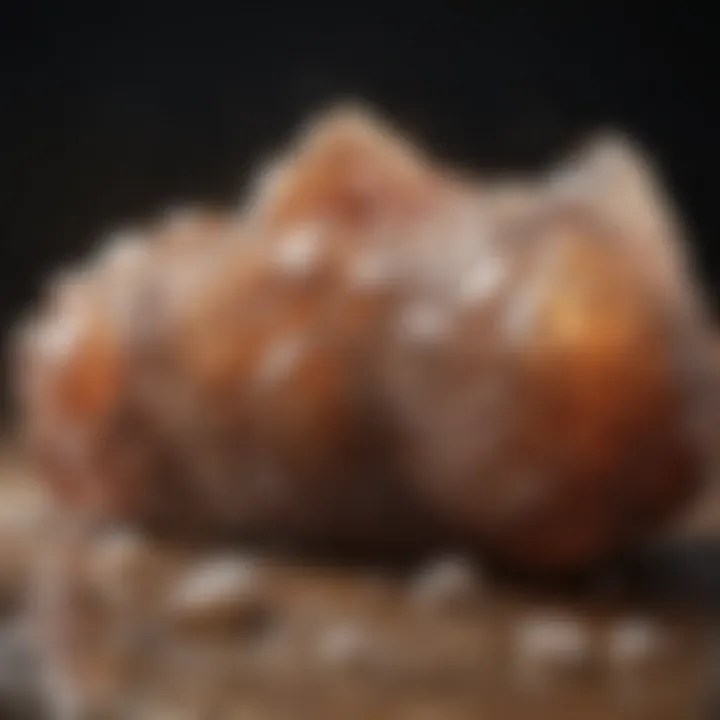
Properties of Effective Quartz Stain Remover
Understanding the properties of an effective quartz stain remover is fundamental for homeowners and design enthusiasts who wish to maintain the beauty and integrity of their quartz surfaces. Not all stain removers are equal. Selecting the right product involves considering its chemical composition, appropriate pH levels, and necessary safety precautions. Each of these elements plays a crucial role in the efficacy and usability of these cleaners.
Chemical Composition
The chemical composition of quartz stain removers determines how effectively they can tackle various stains without compromising the surface. Many commercial stain removers contain a blend of surfactants, enzymes, and acids specifically tailored for quartz. Surfactants help lift and disperse stains while enzymes can break down organic matter.
Moreover, proprietary formulas may include solvents to dissolve harder stains like oils or grease. It is essential to choose a stain remover that specifically states it is safe for quartz surfaces to avoid potential damage. Homeowners should always read labels carefully to understand what chemical elements are included and how they may affect their quartz surfaces.
pH Levels and Their Relevance
pH levels indicate how acidic or alkaline a cleaner is, which can greatly impact its performance on quartz. Effective stain removers generally have a pH level that is neutral or slightly acidic. A neutral pH of around 7 ensures the safety of the quartz material while maintaining cleaning efficiency. Using highly acidic or basic cleaners can indeed result in irreversible damage.
For cleaning purposes:
- Neutral pH (6-8): Ideal for regular maintenance.
- Slightly acidic (5-6): Useful for tackling common stains without risking damage.
Always check the recommended pH level on the product label to make sure it is appropriate for quartz surfaces.
Safety Considerations
Safety should never be overlooked when selecting a quartz stain remover. Many products contain potent chemicals that can be harmful to both humans and pets. Always choose cleaners with user-friendly safety profiles, preferably those labeled as non-toxic or biodegradable.
Some important safety tips include:
- Always wear gloves to protect your hands.
- Ensure good ventilation during usage to avoid inhaling fumes.
- Keep cleaners out of reach of children and pets.
Furthermore, if you experience any adverse reactions, such as skin irritation, discontinue use immediately and consult a professional.
"Choosing the right stain remover not only preserves the beauty of quartz but also protects your health and the environment."
In summary, understanding the properties of effective quartz stain removers is key to maintaining the quality of quartz surfaces. Homeowners should prioritize products with suitable chemical compositions, neutral pH levels, and essential safety factors to ensure both effective cleaning and surface care.
Methodology of Using Quartz Stain Remover
The methodology of using quartz stain remover is crucial as it dictates the overall effectiveness of the cleaning process. Understanding the right steps ensures that stain removal is not only effective but also safe for the quartz surface. Each stage plays a significant role, ensuring that the quartz maintains its integrity and shine while eliminating unsightly blemishes.
Preparation Before Application
Preparation is the first and often overlooked step in the stain removal process. Taking the time to prepare is essential to successful results. Here are some key considerations:
- Clear the Area: Remove any items from the surface to ensure complete access to the stained area. This creates a safe working environment.
- Identify the Stain: Knowing the type of stain can influence the choice of cleaner and the methods used. For instance, oil stains may need different treatment than water stains.
- Gather Supplies: Before starting, make sure you have the correct supplies. This includes the stain remover, clean cloths, a sponge, and water. Having everything at hand streamlines the process.
The importance of preparation cannot be overemphasized. It minimizes the risk of causing more damage during cleaning.
Application Techniques
After preparation, applying the quartz stain remover correctly is vital. Improper application can lead to ineffective removal or, worse, surface damage. Here are standard application techniques:
- Read Instructions: Always start by reading the product instructions. Different products may have specific requirements.
- Spot Test: It's prudent to test the stain remover on a small, inconspicuous area first. This ensures there are no adverse reactions with the quartz surface.
- Apply Evenly: Use a clean cloth or sponge to apply the stain remover. Ensure that it covers the stain fully but avoid excess application, which might leave residue.
- Allow to Sit: Many stain removers require a certain sitting time to break down the stain. Follow the product guidelines for best results.
- Wipe Clean: After the appropriate time has elapsed, carefully wipe away the stain remover with a damp cloth. This step is crucial as it removes both the stain and any leftover cleaner.
Understanding these techniques helps homeowners to effectively manage stains while safeguarding their quartz counters.
Post-Application Care
Post-application care is as important as the previous steps. This phase ensures the surface receives proper maintenance after cleaning:
- Rinse Thoroughly: Make sure to rinse the area with water after using the stain remover. This eliminates any remaining chemicals that could harm the surface.
- Dry the Surface: Use a dry, soft towel to pat the quartz surface dry after rinsing. This prevents water spots and helps maintain its shine.
- Regular Inspection: After cleaning, keep an eye on the area for any signs of lingering stains or damage. Addressing these early can prevent bigger issues.
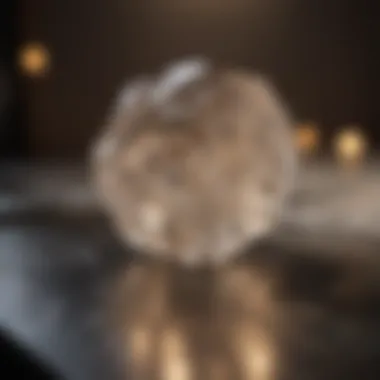

By following these methods, one can significantly extend the life and appearance of quartz surfaces, making them an attractive feature of any home.
Types of Stain Removers Available
Understanding the types of stain removers available for quartz surfaces is crucial for any homeowner or enthusiast. A proper stain remover can significantly impact the appearance and longevity of your quartz materials. Improper cleaning methods can lead to dullness or even irreversible damage. Therefore, knowing your options can empower you to make informed choices on maintenance. In this section, we will explore commercial products and DIY solutions, providing insights that will help you navigate the landscape of stain removers effectively.
Commercial Products
Commercial stain removers are readily available and often formulated specifically for quartz surfaces. They tend to include a mix of chemicals designed to tackle various stains while maintaining the integrity of the quartz material. Brands invest in research and development for these products, ensuring they are effective yet safe for home use. Here are several advantages to using commercial products:
- Specialization: Many commercial products are tailor-made for specific types of stains, such as oil or grease. This specialization can lead to more effective results than using a general cleaner.
- Ease of Use: Brands often provide clear instructions for use, making the application process straightforward and less time-consuming.
- Guaranteed Effectiveness: Most commercial stain removers come with a satisfaction guarantee or return policy, offering additional peace of mind.
When choosing a commercial product, consider key factors such as the specific type of stain, the application method, and safety guidelines. Always read labels carefully to ensure the product is suitable for your needs. Popular options include brands like Bona, Weiman, and Krud Kutter, known for their efficiency and user satisfaction.
DIY Solutions
For those who prefer a hands-on approach, DIY solutions can be both effective and economical. Many homeowners find that they have the necessary ingredients at home to create effective stain removers. These solutions allow for customization based on the stains you are tackling. Here are some DIY methods that have gained popularity:
- Baking Soda Paste: Mix water and baking soda to create a paste. Apply it to the stain and let it sit for a few minutes before wiping it away. This method is great for light stains.
- Vinegar and Water Solution: Use a solution consisting of equal parts vinegar and water. Spray it on the stained area and wipe it clean. This works well for greasy stains. However, avoid using on polished surfaces, as vinegar can cause dullness.
- Hydrogen Peroxide: This is effective for deep stains and can be applied directly to the stain. Allow it to sit for several minutes before rinsing. It is particularly useful for organic stains like wine or coffee.
Using these DIY solutions has the added benefit of being environmentally friendly. However, it is essential to test any homemade cleaner on a small, inconspicuous area to ensure it does not cause damage. DIY methods may require more effort than commercial options but can be rewarding for those who appreciate the craft of maintaining their quartz surfaces.
Evaluating Stain Removal Effectiveness
Evaluating the effectiveness of stain removers is crucial for homeowners and enthusiasts alike. Understanding how to assess various products ensures that one can make informed decisions when it comes to maintaining the clarity and aesthetics of quartz surfaces. With so many options available, determining which remover truly works can save time and avoid unnecessary costs.
When discussing stain removal, the emphasis should be placed on specific features that make a remover effective. These features include the types of stains the product can address, the active ingredients used, and the user-friendliness of application. Factors such as safety, environmental impact, and product longevity also come into play.
Being aware of these elements can help consumers select the best options tailored to their particular needs. For instance, a remover might work well on oil-based stains but fail to address acidic spills. This knowledge arms users with the right tools for proper maintenance. Ensuring a surface remains looking its best is more than an aesthetic choice; it can also contribute to the longevity of quartz surfaces.
Criteria for Comparison
When comparing different stain removers, several criteria should be taken into consideration. Here are some fundamental aspects:
- Stain Compatibility: Not all products tackle every type of stain. Review each product's specifications to identify which stains it effectively addresses.
- Chemical Composition: Knowing the active ingredients helps users understand how a product works. Some removers rely on strong chemicals, while others may be less harsh and more environmentally friendly.
- Ease of Use: The application method influences user experience. Some products may require elaborate techniques, while others are straightforward and consumer-friendly.
- Drying Time: The amount of time a product takes to work or dry can significantly impact how it fits into cleaning routines.
- Aftercare Requirements: Some removers require additional steps post-application to achieve desired results, adding complexity to the process.
- Value for Money: Compare the cost relative to the efficacy of the product. A more expensive option may not always yield better performance than its cheaper counterparts.
Each of these factors is crucial in deciding on a suitable product. An unambiguous understanding of what to look for leads to better choices and superior stain management for quartz surfaces.
User Testimonials and Reviews
User testimonials provide insight into a product's performance beyond what is stated on the label. Real-world experiences expose both advantages and limitations of various stain removers. Reviews can reveal information on:
- Effectiveness Across Different Stains: Users often share their challenges with specific stains, helping potential buyers identify which removers serve particular needs.
- Application Experience: Details on how easy the product is to use help gauge whether it is suited for the average homeowner or better for professionals.
- Post-Use Observations: Long-term testimonials shed light on how quartz surfaces fare after using the product, which is vital when considering maintenance and durability.
- Overall Satisfaction Rates: An aggregate rating from users can provide a quick reference point to gauge overall effectiveness.
By compiling and analyzing user testimonials, homeowners can better navigate the options available to them, focusing on products that deliver on promises. Engaging with platforms like Reddit or forums may also yield candid insights into staining challenges and solutions.
"Understanding the experiences of others can bridge the gap between expectations and reality in stain removal."
Challenges in Stain Removal
Stain removal from quartz surfaces can be a complex task. Understanding the challenges involved is crucial for homeowners and anyone working with these materials. Quartz is popular for its durability and aesthetic appeal, but when stains occur, they can present serious problems. Addressing these challenges effectively ensures the long-term beauty and usability of quartz countertops, backsplashes, and other surfaces.
Persistent Stains
Persistent stains are one of the most significant challenges. These types of stains do not respond easily to conventional cleaning methods. Common sources of persistent stains include coffee, wine, and oils, which can penetrate the surface if left unattended. It is essential to address these stains quickly to avoid permanent damage.
- Why They Occur: Stains can become set due to their chemical makeup. Certain liquids are more likely to bond with the quartz, complicating removal efforts.
- Approaches to Remove: Specialized stain removers may be necessary. Look for products with enzymatic action or targeted chemical makeup.
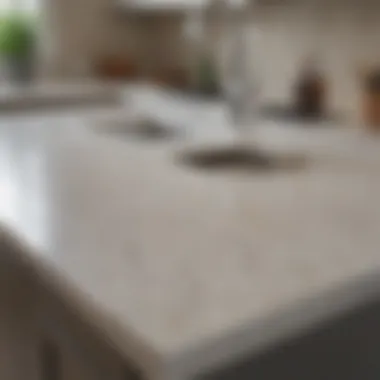
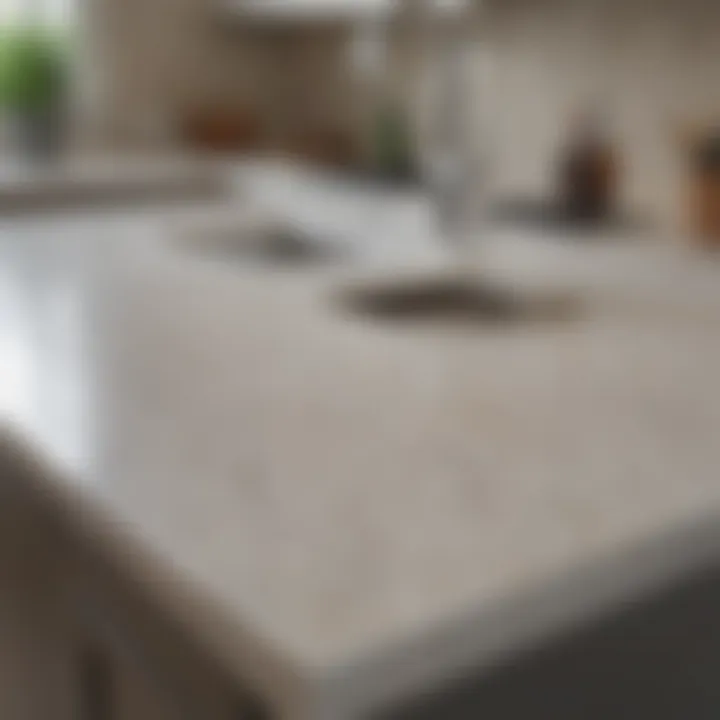
The effectiveness of any stain remover can vary. Hence, testing in an inconspicuous area is often recommended. This can help avoid unnecessary surface damage.
Surface Damage Risks
Using incorrect cleaning methods or harsh chemicals can lead to surface damage. Quartz surfaces may scratch, dull, or lose their gloss if not treated carefully. Understanding the risks associated with certain cleaning agents is fundamental.
- Harsh Chemicals to Avoid: Avoid solvents, bleach, and strong acid-based products. These can compromise the resin that binds the quartz crystals together.
- Recommended Practices: Stick to mild, pH-balanced cleaners specifically designed for quartz. Soft cloths or non-abrasive sponges are ideal for applying cleaning solutions.
Awareness of these challenges can significantly improve care routines for quartz surfaces. By understanding persistent stains and risks of surface damage, users can make more informed decisions and maintain the integrity of their quartz.
Preventative Measures for Stains
Preventative measures for stains on quartz surfaces are crucial for maintaining the aesthetic and functional integrity of these materials. Taking proactive steps not only reduces the frequency of deep cleaning but also extends the lifespan of quartz surfaces. Understanding and implementing these measures enhances user satisfaction, especially for homeowners and individuals who value the longevity of their interiors.
Routine Cleaning Practices
Routine cleaning practices are fundamental to stain prevention. Regularly wiping down quartz surfaces with a soft cloth and mild detergent prevents the buildup of grime and residue. It is essential to avoid abrasive cleaners that can scratch the surface.
- Use Soft Cloths: Always opt for non-abrasive cloths to gently clean surfaces. Microfiber cloths work well.
- Mild Detergents: A diluted solution of dish soap can effectively remove everyday stains.
- Immediate Cleanup: Promptly addressing spills, especially from acidic substances like lemon juice or vinegar, significantly minimizes potential damage.
"The key to keeping quartz looking new lies in diligent routine maintenance and immediate action when accidents occur."
Choosing the Right Coatings
Selecting appropriate coatings can serve as an effective barrier against stains. Some specialized sealants can enhance the surface’s resistance to staining while preserving its shine.
- Sealants: Applications of quartz-specific sealants can create a protective layer, making it harder for materials to penetrate the surface.
- Consult Experts: Seek advice from professionals regarding suitable products compatible with your quartz type.
- Frequency of Application: Depending on the product, reapplication might be needed every few years to maintain effectiveness.
Engaging in these preventative measures ensures that quartz surfaces remain attractive and functional for years to come. By implementing regular cleaning and selecting the right coatings, individuals protect their investment in quartz materials.
Long-term Maintenance of Quartz Surfaces
Maintaining quartz surfaces is not merely about keeping them clean; it is also about ensuring their longevity and preserving their aesthetic appeal. Proper long-term maintenance can prevent wear and tear, preserving the investment many homeowners make in quartz countertops and surfaces. By establishing a routine that incorporates regular care and appropriate cleaning solutions, you can enjoy the beauty and durability of quartz surfaces for many years.
Scheduled Care Regimens
A scheduled care regimen is crucial for keeping quartz surfaces in optimal condition. This includes regular cleaning routines and periodic deep cleans. Establishing a cleaning schedule helps in addressing minor stains before they become major issues.
- Daily Cleaning: Wipe surfaces with a soft cloth and a mild soapy solution. Avoid abrasives that can scratch the surface. This daily practice helps in minimizing residue accumulation.
- Weekly Care: Schedule a more thorough cleaning once a week. Use a non-abrasive cleaner and follow it up with a dry towel to maintain shine.
- Monthly Checks: Inspect countertops for any stains or signs of wear. Attending to these signs promptly will prevent them from worsening.
- Seasonal Deep Clean: Every few months, perform a deep clean using dedicated quartz cleaning products. This not only restores shine but also ensures that any ingrained dirt is removed thoroughly.
Setting reminders can help you stick to this routine. Keeping quartz surfaces well-maintained allows them to retain their structure and color, ensuring that they remain a focal point of the home.
Product Recommendations for the Long Haul
Choosing the right products for long-term maintenance of quartz is important. Not all cleaning agents are suitable. Here are some recommendations to consider:
- Mild Dish Soap: Simple and effective, this is an excellent choice for daily cleaning. It is safe and won't damage the surface.
- Specialized Quartz Cleaners: Look for products specifically designed for quartz. These products often include formulas that enhance shine and help remove tough stains without harming the surface.
- Non-Abrasive Sponges: Soft sponges help in cleaning without scratching or dulling the surface. Avoid steel wool or rough scrubbing pads.
- Sealers: While quartz is non-porous and doesn't typically require sealing, if your specific quartz does, use a high-quality sealant designed for quartz surfaces. It will help prevent stains from setting in over time.
Remember that using the right products can significantly extend the lifespan of your quartz surfaces, retaining their value and visual appeal.
By sticking to a well-structured care regimen and choosing appropriate products, homeowners can enjoy their quartz surfaces' functionality and beauty, ensuring they remain a valuable part of their home for years to come.
Final Thoughts on Quartz Stain Removers
In the realm of home maintenance and interior design, understanding quartz stain removers holds significant value. As quartz surfaces become increasingly popular for their durability and aesthetic appeal, the ability to maintain these surfaces becomes critical. Stains, which can arise from everyday activities, can diminish the beauty and functionality of quartz. This is where effective stain removal becomes essential, as it allows homeowners to preserve their investments and ensure longevity.
Importance of Choosing the Right Stain Remover
Using the appropriate stain remover not only helps in maintaining the appearance of quartz surfaces but also protects them from potential damage. Incorrect methods or harsh chemicals may lead to irreversible harm. Homeowners must be diligent about selecting stain removers that align with the specific needs of quartz. Myriad options are available, ranging from commercial products to DIY solutions. Understanding these differences helps in making informed decisions.
Benefits of Regular Maintenance
Regular maintenance through the right cleaning techniques is one of the best defenses against stains. Homeowners can save time and resources by implementing simple preventative measures. This can include proper cleaning regimens and using protective coatings for quartz surfaces. A proactive approach minimizes the need for intensive stain removal processes later.
"The key to maintaining the elegance of quartz surfaces lies in understanding and implementing suitable stain removal techniques."
Consideration of New Technology
Advancements in technology continually shape the landscape of stain removal. Future directions in this field may lead to the development of more effective and environmentally friendly options. Homeowners and industry professionals alike should remain attentive to these innovations. Keeping abreast of new products can ensure better cleaning outcomes while minimizing environmental impacts.



